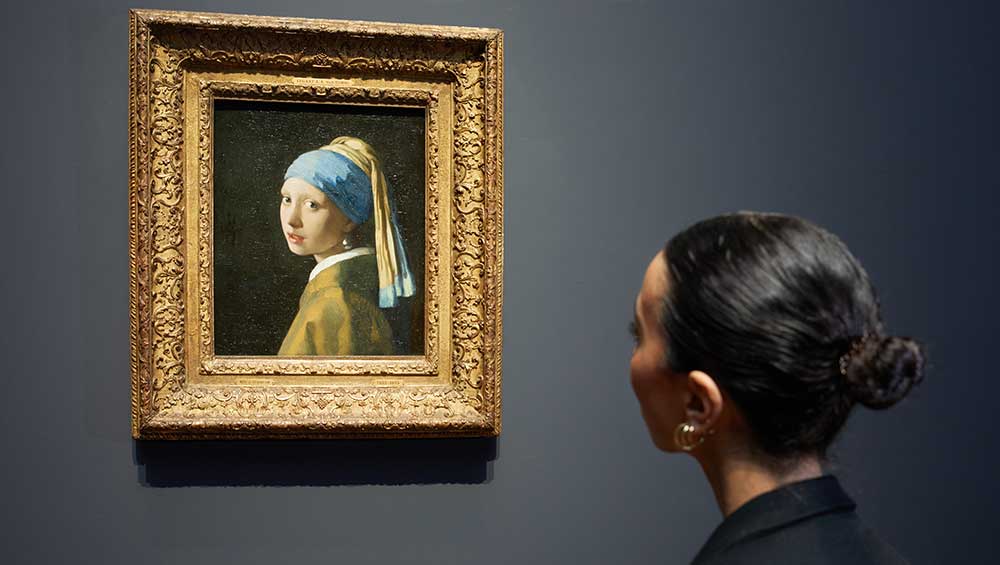
Vermeer exhibition. Photo: Rijksmuseum / Henk Wildschut.
Rijksmuseum, Amsterdam
10 February – 4 June 2023
by JULIET RIX
The show starts appropriately where this star of the Dutch golden age, Johannes Vermeer (1632-75), started – where he was born, raised, married, worked and died – in the small, but at times influential, town of Delft. The first room contains two images of the town – The Little Street (c1658-9), one of the Rijksmuseum’s own four Vermeer paintings, and View of Delft (c1660-61), one of the 24 loans, this one from relatively close, in the Hague, but others from across the world.
.jpg)
Johannes Vermeer, The Little Street, c1658-9 (detail). Installation view, Rijksmuseum, Amsterdam, 2023. Photo: Juliet Rix.
The Little Street is a perfect opener, a deceptively simple domestic street scene in which Vermeer uses his characteristic skill with light to take the viewer’s eye to the two busy women – one in the doorway, highlighted by her white headdress and shawl, the other just through an archway in a side alley – who occupy the borderland between public and private realms. The private realms, that is, which provided Vermeer with the setting for his most famous works.
But before we go inside, it is worth spending a bit of time in front of View of Delft. It is a luminous landscape – and luminous is the word that constantly comes to mind throughout this exhibition. Here it is in the water, the sky, and the dots of “light” illuminating a ship’s hull, a gable. We are not inside Delft but looking at it. Like The Little Street, this is a borderland of hinterland and town. We are outside, our gaze drawn towards the built-up interior by the warm light glowing on the buildings beyond the bridge.
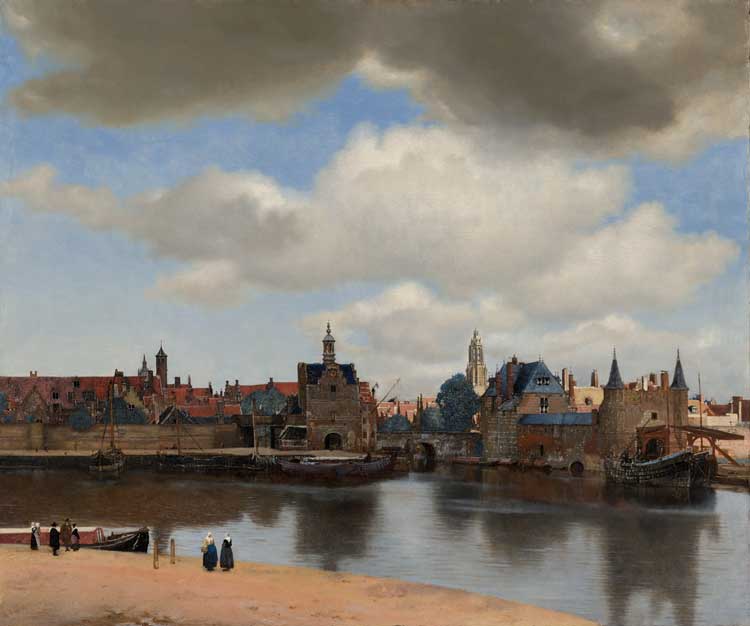
Johannes Vermeer, View of Delft, 1660-61. Oil on canvas. Mauritshuis, The Hague.
As in so many Vermeers, the composition is beautifully balanced – and he was not above the occasional adjustment to true topography to achieve this. Typically also, the balance stems not only from geometric composition but from light and colour – particularly blue. The slate-blue roofs are echoed in a woman’s skirt, the edge of a ship, as well as dapples on the water. In spite of this picture being a different genre from most of Vermeer’s work, much is characteristic.
There is one more room of pictures before we enter the interior. The exhibition’s second room takes us back a few years to the mid-1650s, just after Vermeer was accepted into Delft’s Guild of St Luke as a master painter. The four works here see the young master building his reputation within the artistic taste of the day, which placed history painting at its pinnacle.
Yet there are clues to the future in these large canvases. The attribution of both St Praxedis (1655) and Diana and Her Nymphs (c1655-6) have been questioned, but the Rijksmuseum is of the view that they are Vermeers. Despite St Praxedis (a saint rarely depicted outside Italy) being a near-copy of a work by a contemporary Florentine artist, Felice Ficherelli (Vermeer’s only known copy), they both show Vermeer already choosing unusually private, intimate moments to illuminate mythical and religious subjects typical of history paintings. Diana is having her feet washed, while St Praxedis is quietly squeezing the blood of a martyr from a sponge into a decorated vessel.
.jpg)
Johannes Vermeer, Christ in the House of Mary and Martha, c1654-5. Installation view, Rijksmuseum, Amsterdam, 2023. Photo: Juliet Rix.
In Christ in the House of Mary and Martha (c1654-5), Vermeer’s largest painting, there is little but the three characters. They are closely connected by the way they are looking at each other – Christ probably pointing out to Martha (as the Bible story goes) that Mary is listening to him while Martha remains distracted by household duties.
It is notable that two of these large paintings – almost certainly commissions – have overtly religious subjects unusual in the rest of Vermeer’s oeuvre. This may well be related to his marriage on 20 April 1653 to Catholic Catharina Bolnes initiating him into a Catholic milieu. It is not known whether Vermeer converted to Catholicism but there is little doubt that, despite restrictions applied to the religion by the Dutch Republic at the time, Catholicism was the primary faith in his marital home. The co-curator of the exhibition, Gregor JM Weber, the Rijksmuseum’s head of fine and decorative art, has made a particular study of Vermeer and Catholicism that has just been published as a book, Johannes Vermeer: Faith, Light and Reflection, to coincide with the opening of this show. It sheds new light on the influence of Catholicism and the Jesuits on the artist’s life and art.
Vermeer was baptised into the Dutch Reformed church and brought up as a Protestant, but after his marriage he lived in a neighbourhood of Delft known as the Papenhoek – Papists’ Corner. None of his children was baptised or married in the local Reformed church (the records from this church survive, while those of the local Catholic church are lost) and, Weber points out, all were given the names of Catholic saints, and a grandson even became a Catholic priest.
One of Vermeer’s sons was called Ignatius, a name inextricably linked with Ignatius of Loyola, founder of the Jesuits, and Delft had a Jesuit station with a “hidden church” and a girls’ school, a couple of doors from the Vermeer family home – both from the house long assumed to have been their home and from the neighbouring house that Weber has now identified as theirs (as a result of a closer reading of the inventory taken on Vermeer’s death). The house may even have been rented from the Jesuits.
This Catholic connection, Weber argues, may be all-important to Vermeer’s art, particularly to his exceptional use of light. Divine light was a key part of Jesuit theology, a way of depicting the presence of God. This likely influence, says Weber, impacts Vermeer’s non-religious as well as his few religious paintings, and includes his characteristic employment of tiny dots of light-coloured paint to illuminate his work from the late 1650s onwards.
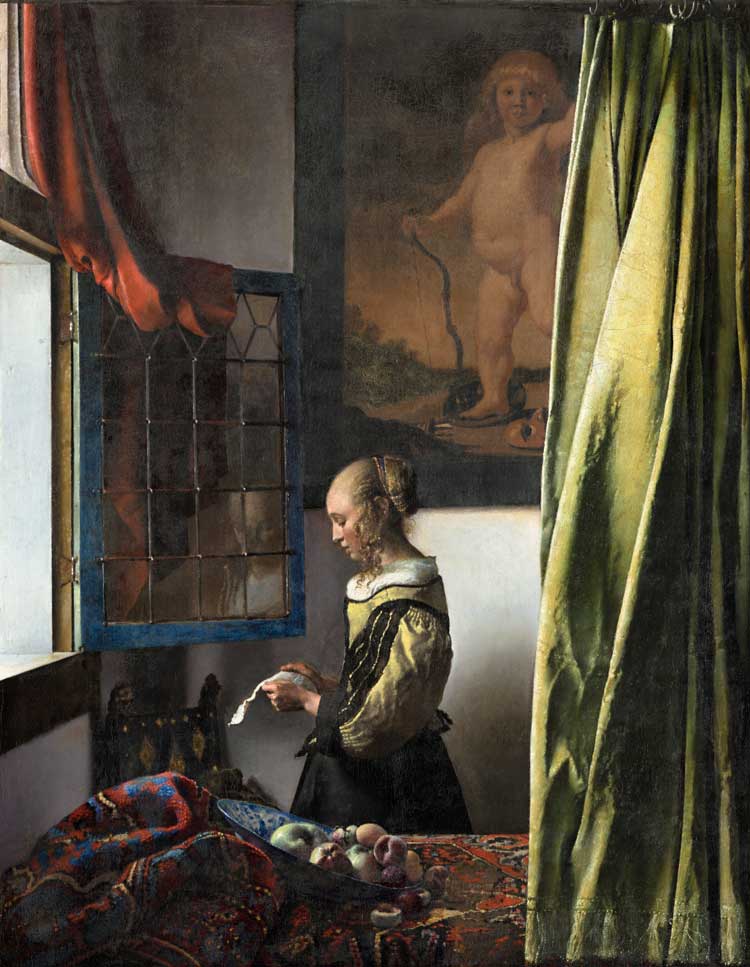
Johannes Vermeer, Girl Reading a Letter at an Open Window, 1657-58. Oil on canvas. Gemäldegalerie Alte Meister, Dresden.
Room three opens with the first known picture to employ this technique, and an early example of what was to become seen as typical Vermeer: a female figure engaged in a task, caught in a quiet moment in a room corner lit from a window. Girl Reading a Letter at an Open Window (c1657-58) is an immaculate opener for this “interior” section of the show. The girl reads her missive with complete concentration, her face impressionistically reflected in the leaded glass of the window, the daylight from which highlights her face, the letter, fruit in a bowl at a precarious angle, and the silky green curtain that hangs theatrically close to covering the scene.
On the wall behind the girl is a painting of Cupid, only recovered from beneath overpainting a few years ago, adding a clearer meaning to the work. The paper in the girl’s hand now appears to be a love letter. Cupid is as large as the girl, so he is certainly meant to be noticed, and love’s archer is stomping over a couple of masks, symbols of deception, demonstrating (or warning) that true love requires no fakery. As for the new dots of “light”, they shine particularly in the girl’s ringlets, the decoration on her dress, and the lime-green curtain. We see this technique used with greater intensity still in The Milkmaid (c1658-59), the golden crusts of bread beside the maid enlivened by glistening flecks of “light”. Weber suggests that these “light dots” emerge from Vermeer’s acquaintance with the camera obscura, which in bright light creates such an effect. He is not saying that Vermeer painted using a camera obscura, more that knowledge of it informed his way of seeing.
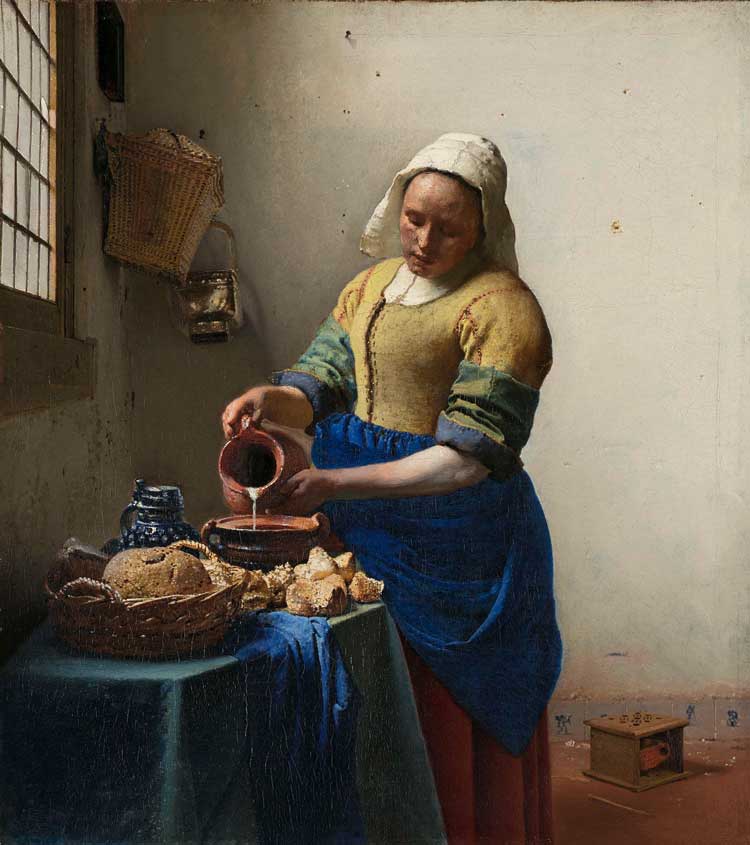
Johannes Vermeer, The Milkmaid, 1658-59. Oil on canvas. Rijksmuseum, Amsterdam. Purchased with the support of the Vereniging Rembrandt.
The camera obscura was well-known to the Jesuits and while there is no proof that the Delft Jesuits owned one, we do know that Jesuit stations elsewhere in Europe did. The order had several members, too, with state-of-the-art knowledge of optics, which this religious community used to demonstrate the divine light of God. Weber suggests that Vermeer’s physical, social and religious proximity to the Jesuits prompted, or at least enhanced, the intensity of the light in his paintings.
-JR-(8).jpg)
Johannes Vermeer, Allegory of the Catholic Faith, c1670-74 (detail). Installation view, Rijksmuseum, Amsterdam, 2023. Photo: Juliet Rix.
The only explicitly religious painting later in the exhibition (and the oeuvre), Allegory of the Catholic Faith (c1670-74) feeds Weber’s theory. Thick with Catholic imagery, including an apple with a bite out of it (symbolising the fall from Eden) and a snake squashed by a stone (victory over evil), the central allegorical figure of Faith looks up at a glass globe hung from the ceiling. Weber has uncovered Jesuit writings and drawings that present such a globe as a way to “grasp what cannot be grasped”, ie through reflection, the sphere gathers everything around it into one whole.
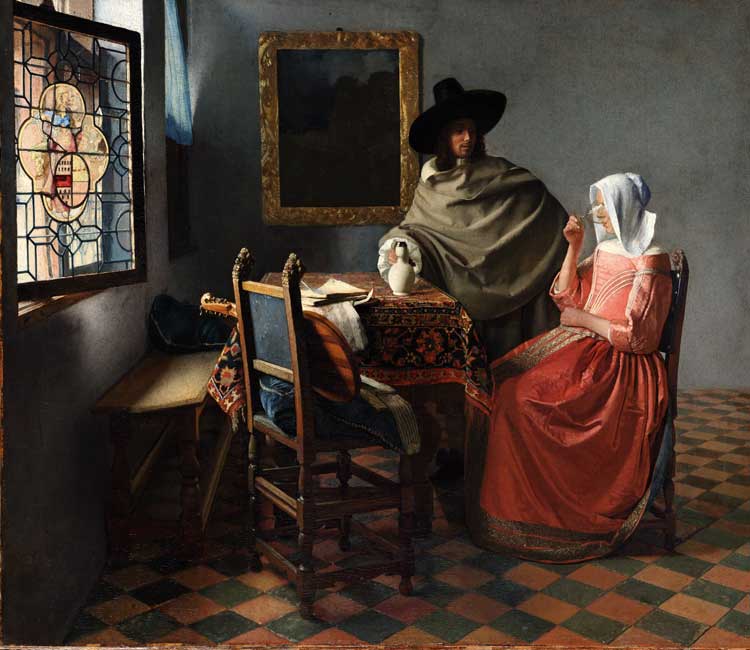
Johannes Vermeer, The Glass of Wine, c1659-61. Oil on canvas. Staatliche Museen zu Berlin – Gemäldegalerie.
Most of Vermeer’s famous interiors are not overtly religious, but few would disagree that they are infused with a “divine” light, at least in the secular use of the word. In The Glass of Wine (c1659-61), the woman’s face is seen through the glass from which she is drinking, which also reflects the light from the window. The man watches her, his hand resting on the bright white wine jug, ready to refill her glass – with a clear suggestion of intent.
-JR-(1).jpg)
Johannes Vermeer, The Glass of Wine, c1659-61 (detail). Installation view, Rijksmuseum, Amsterdam, 2023. Photo: Juliet Rix.
Vermeer probably drew inspiration for this and similar lighthearted domestic scenes from the older artist and sometime Delft resident Pieter de Hooch (1629-84), but Vermeer has a particular capacity to balance and integrate everything in his scenes, raising a small, simple, genre painting to something sublime.
Reflections play a key role, including the famous pearl earrings. And in an exhibition of so many Vermeers, it is marvellously apparent that pearl earrings illuminate the faces of many more than just the most famous of Vermeer’s women. In fact, pearls of some kind appear in about half his works. Sometimes the earrings are accompanied by the almost tactile satiny surface and ermine-style fur (very unlikely to have been actual ermine in 17th-century Netherlands) of the recurring yellow jacket.
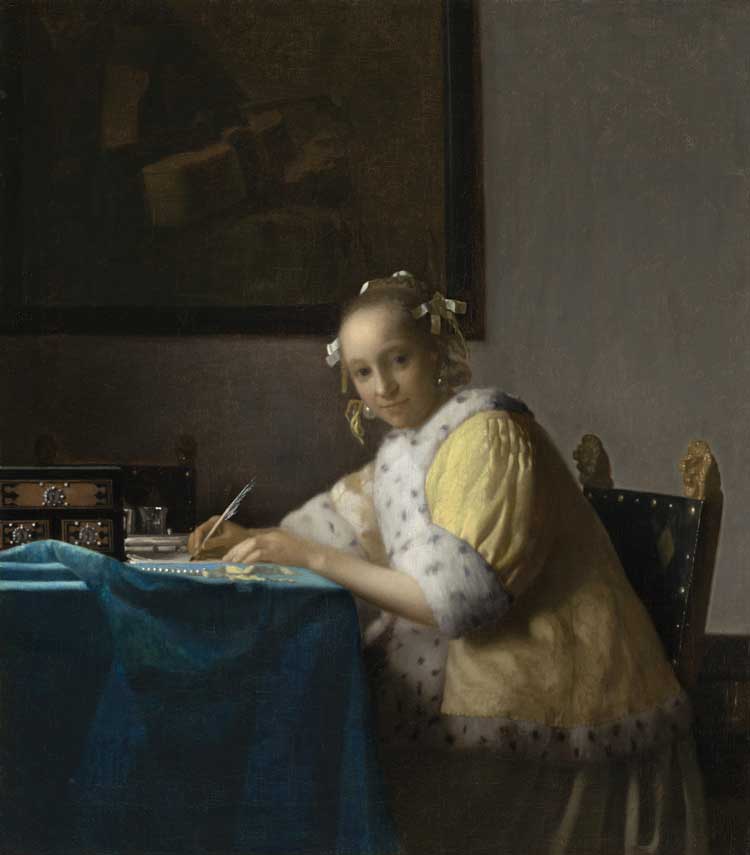
Johannes Vermeer, A Lady Writing, 1664-67. Oil on canvas. National Gallery of Art, Washington. Gift of Harry Waldron Havemeyer and Horace Havemeyer Jr., in memory of their father, Horace Havemeyer.
In Young Woman With a Lute (c1662-4), the lady’s face is lit from the window she is looking out of, while the earring glistens on the shadowy side of her visage. The eponymous figure in A Lady Writing (c1664-67) looks out at us from within a circle of illuminations – two pearl earrings and intensely white ribbons in her hair – almost like the lights of a particularly delicate dressing-room mirror.
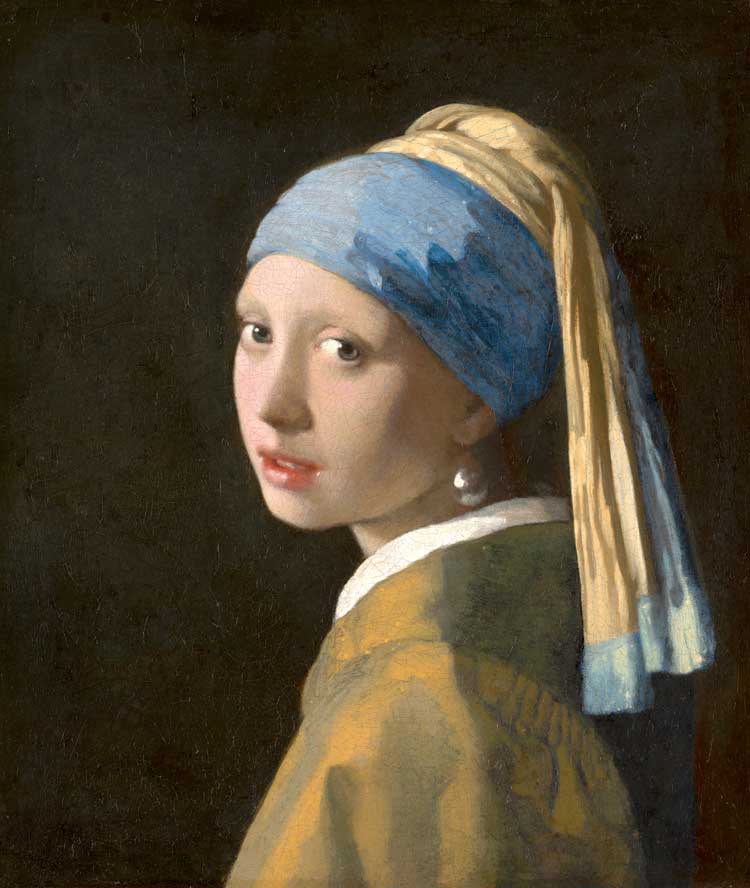
Johannes Vermeer, Girl with a Pearl Earring, 1664–67. Oil on canvas. Mauritshuis, The Hague. Bequest of Arnoldus Andries des Tombe, The Hague.
Girl With a Pearl Earring (1664-67) distils all this, pares it back to the essential. It is all about her; the girl looks out from a plain background, her bright eyes echoed and enhanced by her white collar, the tip of her headscarf and, of course, that earring. Her look is so direct, so completely focused on the viewer, it is little wonder Tracy Chevalier felt the need to write a whole novel probing who she was.
To call this picture a tronie (a study of a generalised facial expression) hardly does it justice, and there is another facial “study” in this show that is particularly striking. Girl With a Red Hat (c1664-67), probably a precursor to Girl With a Pearl Earring, doesn’t bother with the earrings. Instead, Vermeer simply places white highlights wherever he sees fit, cradling the girl’s face with them, and even illuminating the top of her nose. This picture reminds me of Renoir, and it isn’t just the blues and reds but also the textures, the variable focus, and the almost impressionistic rendering of the red hat.
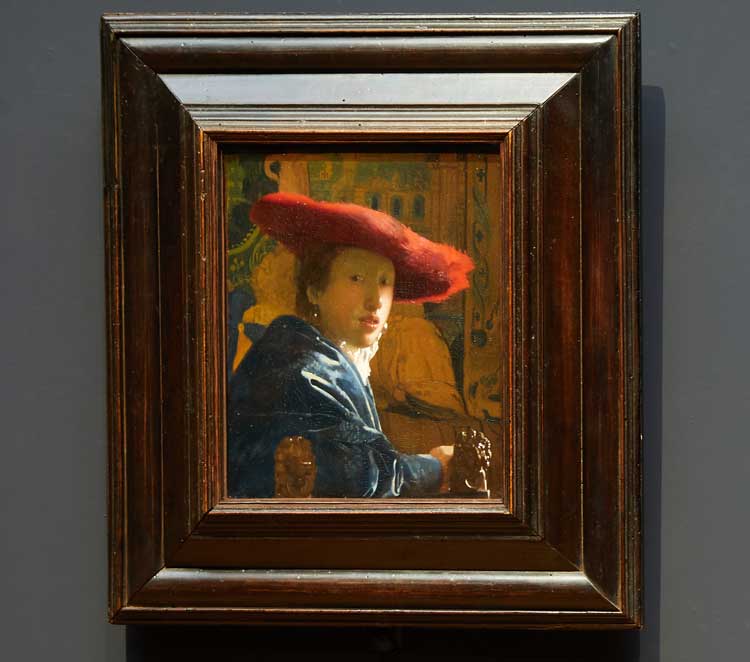
Johannes Vermeer, Girl With a Red Hat, c1664-67. Installation view, Rijksmuseum, Amsterdam, 2023. Photo: Rijksmuseum/ Henk Wildschut.
The Girl With a Red Hat, like the Girl With a Pearl Earring looks at us in a way that completely bridges the gap between viewer and subject. This is true of the central characters in a number of Vermeer’s paintings. But he also frequently goes to the other extreme: we observe the subject who is unaware of being observed, peeking in on a private moment.
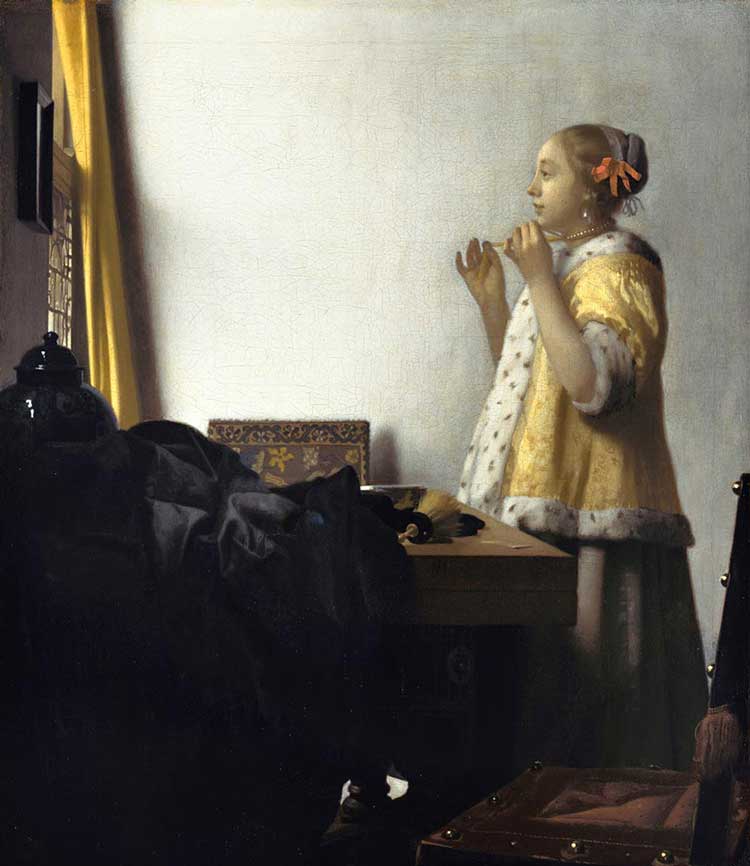
Johannes Vermeer, Woman with a Pearl Necklace, c1662-64. Oil on canvas. Staatliche Museen zu Berlin – Gemäldegalerie.
This last is the case in the delightful Woman With a Pearl Necklace (c1662-64); The Love Letter (c1669-70) in which we are looking in from an adjacent room, and all the communication is between the two depicted women; and in what is perhaps Vermeer’s ultimate image of introverted concentration, The Lacemaker (c1666-68). There is something meditative about watching someone entirely engrossed in what they are doing, and Vermeer captures that feeling.
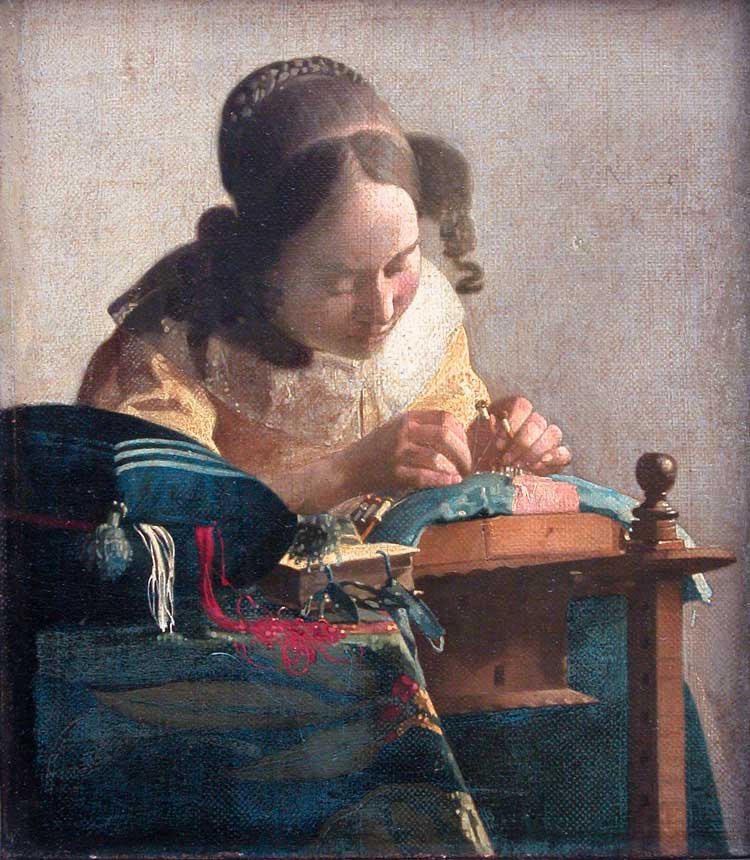
Johannes Vermeer, The Lacemaker, 1666–68. Oil on canvas mounted on panel. Musée du Louvre, Paris.
The Lacemaker has an interesting variation of painterly clarity, too. The threads are sharply defined while the face is in soft focus. This, Weber says, is further evidence for Vermeer’s familiarity with the focal planes of the camera obscura.
Weber’s research makes a significant contribution to our view of Vermeer, particularly as so little about his life is documented. We know nothing about his training, there are no letters or diaries, and no known portrait or self-portrait (though there has been speculation that the musician in The Procuress, 1656, is Vermeer). We know his father was a part-time art dealer and his parents ran a pub, the Flying Fox, in the heart of Delft. Vermeer and Catharina had 15 children, of whom 11 survived infancy and it was, according to his wife, his inability to provide for them following the economic collapse precipitated by the French invasion of the Netherlands in 1672 that broke her husband and led to his death in 1675, aged just 43.
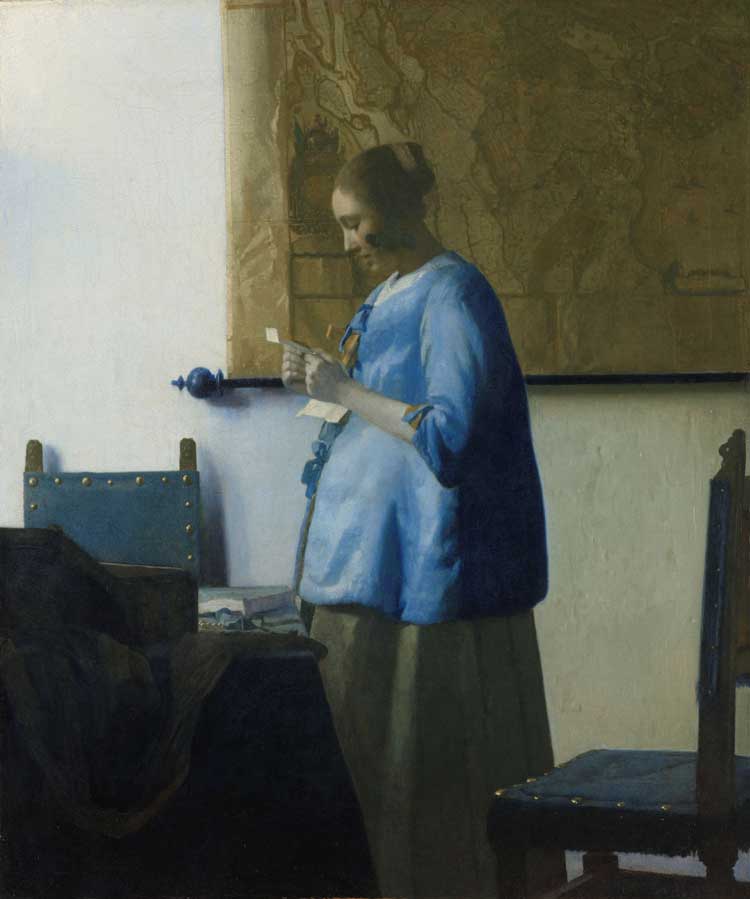
Johannes Vermeer, Woman in Blue Reading a Letter, 1662-64. Oil on canvas. Rijksmuseum, Amsterdam. On loan from the City of Amsterdam (A. van der Hoop Bequest).
The new research attached to this show, then, justifies the exhibition motto, “Closer to Vermeer”, and it isn’t only historical research. There was also an extensive programme of technical analysis of the paintings ahead of the hang. A scan of The Milkmaid, for instance, found that not only is there still a hole above the woman’s left shoulder (visible if you look closely) that the artist used to mark his perspective vanishing point, but there was originally a jug rack on the wall behind her. Vermeer, however, painted this over, preferring to leave the background plain, focusing the viewer on the central character and this stilled moment of her activity.
Scans also revealed extensive underpainting. Beneath the impeccably finished surfaces of Vermeer’s works, Weber tells me, lie sketches that are “so fresh, vivid, dynamic … the brushwork so loose and spontaneous”, that they have prompted a redrawing of the long-accepted image of Vermeer as an always-meticulous slow-worker.
He does seem to have worked slowly – or infrequently – however. His total oeuvre is thought to have numbered 45 to 50 paintings, an average of just two a year, far fewer than contemporaries such as Rembrandt or Frans Hals. Thirty-seven Vermeers survive, of which 24 are signed. Twenty-eight of them are in this exhibition. That may not seem like a large show, but, as Weber puts it, “when every painting is a highlight of its home collection”, you want to engage intimately with every one of them.
To its credit, the Rijksmuseum understands this. Despite the show’s popularity, it has limited numbers, spread the pictures to allow each its individual space, and placed information boards away from the works. It pays off. This is a show in which to linger, to delve into, to savour; an exhibition that really does invite you closer to Vermeer.